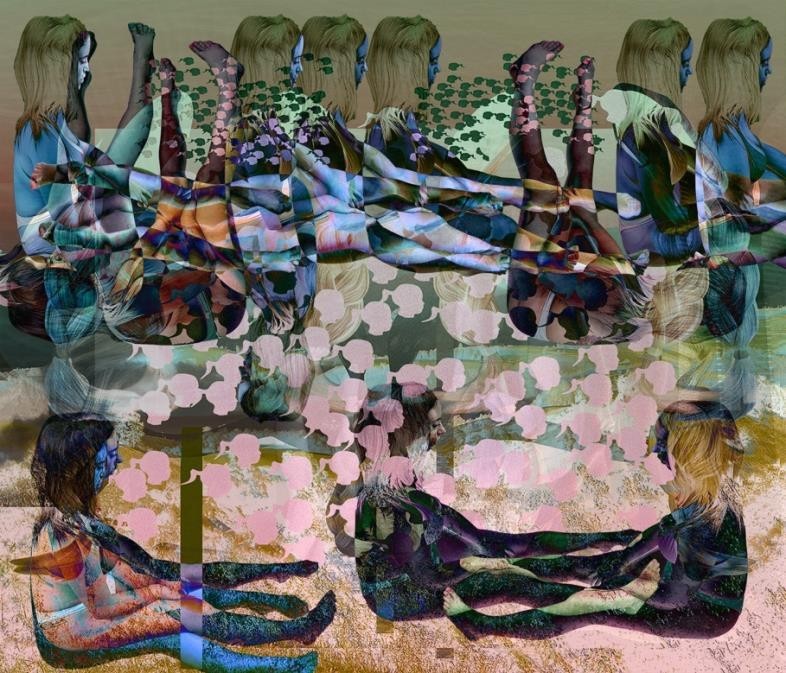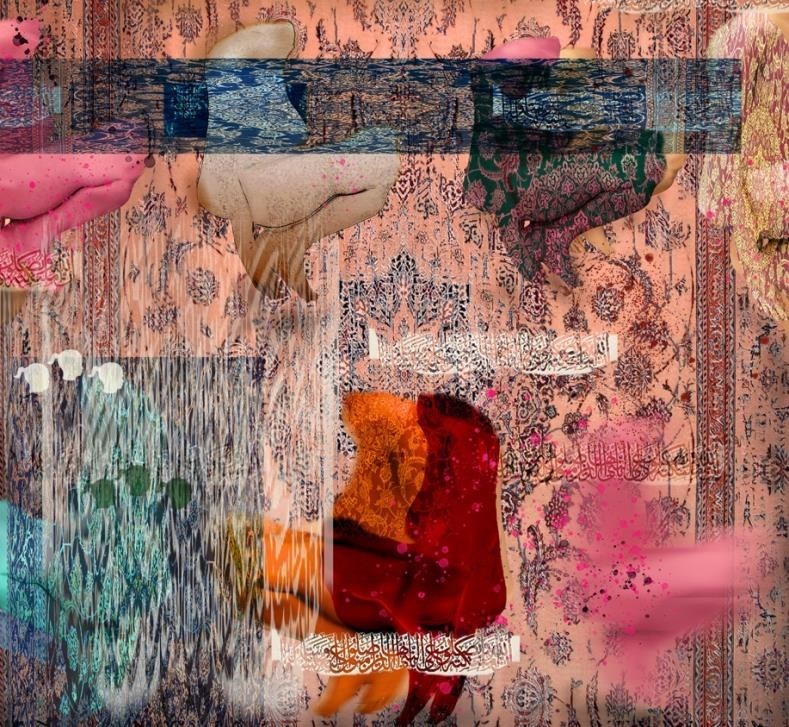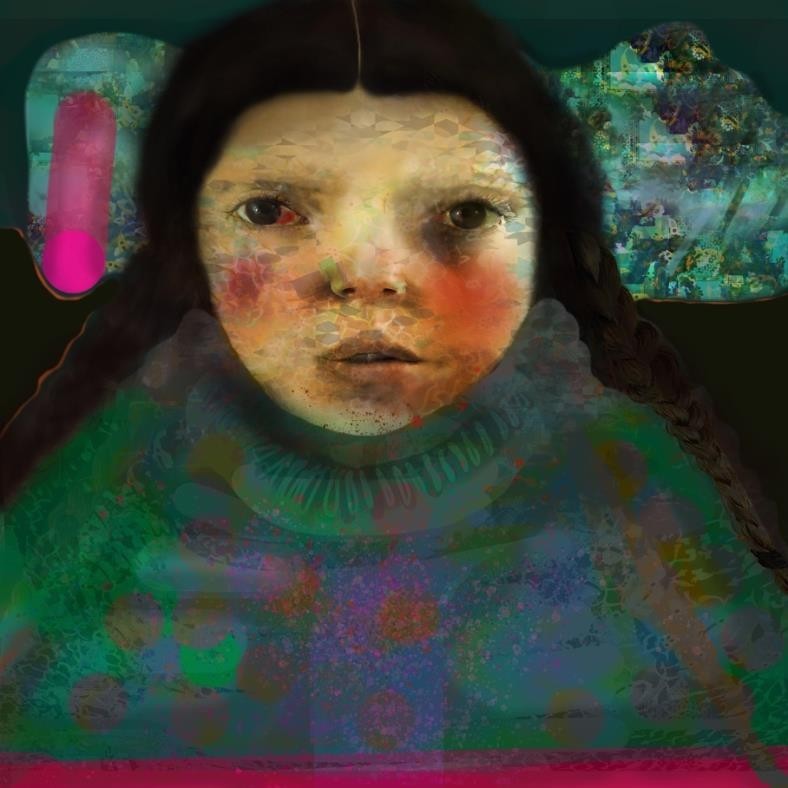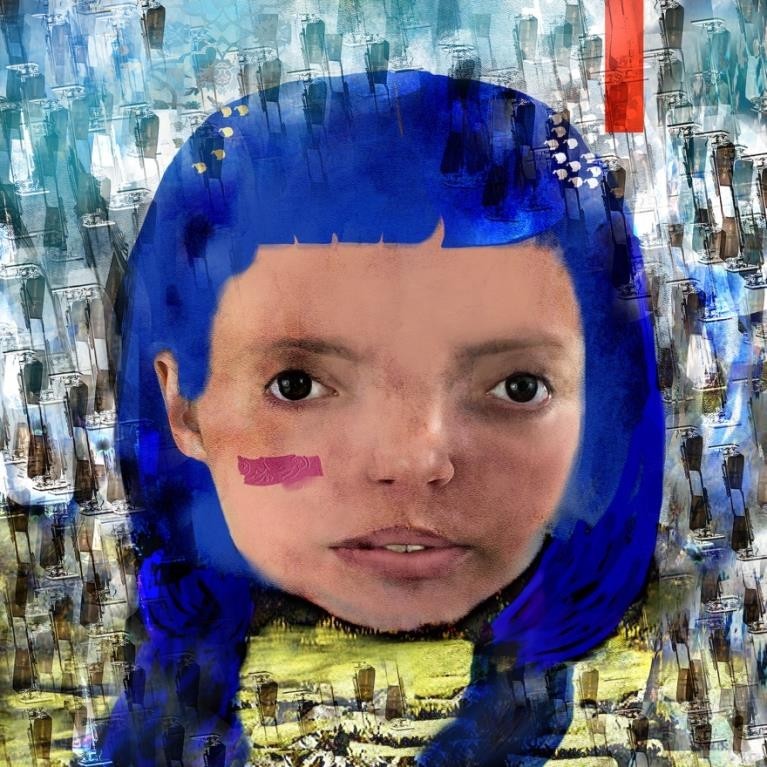By Liz Goldner
Fatima Franks brings a variety of visual and philosophical influences to her artworks. She incorporates into her art the humanistic and intellectual values she learned from her parents, along with her experiences as an art student, art instructor, working artist and engaged member of Eastern and Western cultures. These cultures include Pakistan where she grew up and her relocations to Canada and the United States.
Franks’ father was a colonel in the Pakistan Army. Her mother, with a Master’s Degree in Political Science, strongly influenced her awareness of social and political issues.
She continues to pursue these interests today, expressing their importance in her artwork.
The artist’s childhood home was filled with art and artifacts from all over the world. These included oil paintings, gilded vases with designs, porcelain figures, ornate Islamic daggers and intricate hand-knotted Persian and Afghan carpets. The elegant environment fascinated her early on and still does today. Greatly encouraged by her parents to follow her artistic bliss, she absorbed herself in art as a child — her “unstoppable passion” — and still does.
By the time, Franks was a teenager, she knew that she would be an artist when she grew up. With her parents’ blessings, she attended the Indus Valley School of Art and Architecture in Pakistan. Experiencing the powerful imaginative environment there helped her construct her creative thought processes and concepts, and abilities to execute philosophical ideas. When she graduated with a BFA in studio art, she was already a professional exhibiting artist.
After moving to California in 2007, Franks enrolled at California State University, Fullerton, receiving an MFA in studio art three years later. She then studied Digital Art Extension at Otis College of Art and Design in Los Angeles, soon after making digitally executed paintings.
Franks immerses into her art the details of arabesque carpet designs she saw as a child. She references in her work patterns from her mother’s wardrobe, including her refined floral chiffon and embroidered pashmina shawls. She expresses a deep connection with these early influences, which she says are organically part of her work today.
Working with digital mixed media paintings and collages, and with ceramics and short films, Franks focuses on the stigmatization, sexual objectification and gender inequalities faced by women. She addresses “our worldwide patriarchal constructs” — redirecting these paradigms towards an evolving global discourse on women. She is striving in her work to create an awareness of the evolving value systems and reforms in attitudes toward woman, which are emerging from multiculturalism. Her art flows from her intuition, and from her wide-ranging life experiences.
Franks uses found images, her own photography, childhood recollections, knowledge of world affairs and visions of a better world to build complex images. She stylizes and montages her metaphorical images with floral landscapes and Islamic influenced patterns, combined with historical references, poetry, feminist theories, gender issues, and sexuality. Her mixed media artworks contain coded meanings, representing birth and death of cultures, politics, feminism, sexual and gender inequalities. Her recurrent symbol of the ponytailed silhouetted female head expresses her vision of women’s positive experiences, ideologies, and personal beliefs.
The female figures in Franks’ work have embraced their inner goddesses and gained the courage to liberate themselves by vanquishing their weaker selves. These females rise above influences that strive to de-soul them or take away their abilities to be their true selves in our “progressive” society.
Examples of these images are her recent composite montages displayed at the Great Park Gallery in Irvine, California. In Indigo Doll no.2 and Roseate Ichor MMXIV, she explores what she calls “intersectional feminism.” In these pieces, she illustrates the many ways that women experience discrimination, along with the complexity of prejudices that they face. Indigo Doll no.2, in particular, conveys the satirical identity of women as ‘dolls.’ shaming, disability, and physical appearance not addressed in white feminism. Roseate Ichor MMXIV addresses the often-hidden narrative of women who have endured gender-based violence, along with situations of women who have fewer economic advantages than men have. The subjects in Indigo Doll no.2 and Roseate Ichor MMXIV stare at the viewers confrontationally and relentlessly, while demanding political reforms regarding domestic violence.
This coming June, Franks will show her composite montages of females in a solo exhibition at the Chawkandi Gallery in Karachi, Pakistan. The contemporary art gallery represents important artists such as Zahoor ul Aklaq, Shahid Sajjad, Chughtai, Sadequain, Ahmed Pervaiz, Bashir Mirza, Colin David, Ismail Gulgee, amongst others. All of her work in this exhibition will be newly created, while addressing the feminist themes that she is well known for.
Franks is inspired by the writings of Jungian analyst Clarissa Pinkola Estés, Ph.D. who wrote in her 1992 book, “Women Who Run with the Wolves,” “Creativity is the ability to respond to all that goes on around us, to choose from the hundreds of possibilities of thought, feeling and action, and reaction and to put these together in a unique response, expression or message that carries moment, passion and meaning…Focusing is the use of all our senses, including intuition. It is from this world that women come to claim their own voices, values, imaginations, their clairvoyance, their stories, and the ancient memories of women. And these are the work of focus and creation.”
Art and creativity are for Franks the opportunity to pause, reflect and engage with the social and political constructs and influences — both positive and negative — in this world. The artistic process provides her with the power to engage in visionary inner dialogues and in dialogues with others.
Liz Goldner is an award-winning art and cultural journalist based in Orange County, California. She contributes to several print and online publications.


























